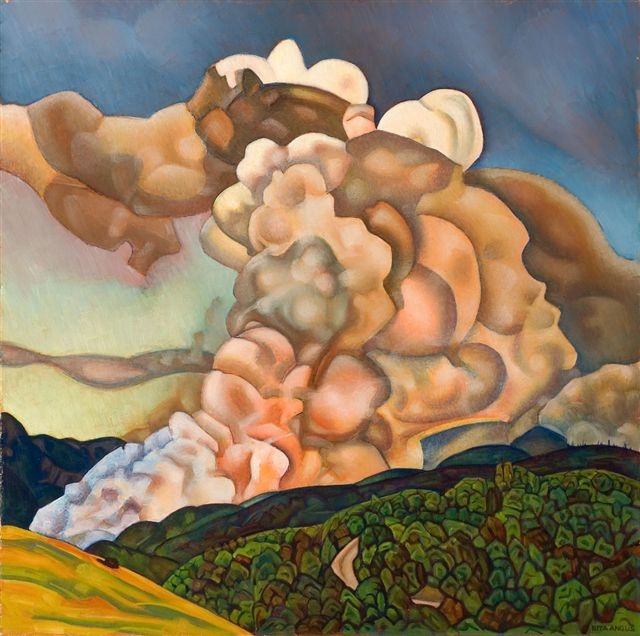Thursday 16 August 2012
Ron Brownson

I recently asked on this blog what Rita Angus’s voice sounded like. I was telephoned by Petar Vuletic and he told me that he knew her well towards the end of her life. I asked Petar to draft some recollections about the artist. Petar kindly sent me the following memoir; which I have illustrated with a painting that Rita painted shortly before she met him.
I first met Rita Angus when I bowled up to her home in the 60s. I was a young university student. I arrived unannounced and she graciously received me. After that, we would meet whenever I came to Wellington. This was over a period and I have not thought about it really until now when someone mentioned your blog and that you were interested in what Rita had sounded like.
We would go for long walks around Wellington -for hours at a time and on one occasion for nearly 6 hours. I recall on the last walk we ever had, we would pause every 100 yards or so, for her to rest and then carry on. During these walks, she would be pointing things out that were of interest and relevance to her. For example - the pile of gravestones that had been uprooted from a cemetery to make way for a motorway. This was a short distance from where she lived, landmarks such as the French Maid coffeehouse. On these walks we would be discussing art, what had influenced her and in particular what had influenced her the most. I recall in this regard her telling me that what had been the seminal influence on her art had been an exhibition of Canadian Regional Art (in the 1930s).
I recall her also telling me how upset she was about some of what was being written about her and her art and how strongly she disagreed with it. She disagreed about there being a so-called ‘harsh quality of New Zealand light”. It has nothing to do with my work she had said more than once. Also she showed me some of her works which included small abstract paintings one of which was I thought exceptional. I believe that this work went to North America and I have never seen it since. Curiously, it reminded me of both Malevich and Kandinsky. We talked about other art and artists such as Theo Schoon. I recall her talking about the Milligans who used to host regular meetings for artists in their circle.
After our walks; and sometimes before we set out, she would make me a cup of tea at her home. The china was English bone china. As a consequence of our long walks and the time spent together I have a very distinct recollection of her voice. As you may appreciate, it is difficult to describe such things.
However, as my first language is not English, I have always been interested in accents, and in the different forms of regional and class dialects in New Zealand (as an outsider -born here, but nonetheless apart.) Some districts have terms peculiar to that region for example - containers in which strawberries are sold were called variously: pottles, (Dunedin), punnets, (Wellington), and chips. (Auckland). New Zealanders have considerable variation from province to province and island to island. It may seem less so to those whose first language is English, as one never perceives that one has an accent oneself, instead, it is all about other people.
From my perspective, I should describe her speaking voice as strong and firm, not loud but quite forceful. Clear in enunciation, precise, and never mumbling or indistinct. I should describe her as having a New Zealand educated, provincial accent. Not twangy, reflecting or so it seemed an accent more usual when one is from a comfortable financial background- but particularly such as found in the Hawke’s Bay and lower North Island. Not like the Remuera version of the received pronunciation of English. Nor was it like the Fred Dagg parody of New Zealand English, so beloved by advertising agencies and others who like to over exaggerate, to make a difference when the subtleties are there, anyway.
I have a 92 year old aunt, born in Carterton, and educated there and in Horowhenua, whose grandmother was a teacher and father a farmer, whose accent reminds me very much of Rita Angus. Words and phrases from those places and those times recur in her speech and also remind me of Rita.
This is how it seems to me looking back now after all these years. Rita seemed to like me. She was very open and forthcoming. I doubt that I was unique in this. Over the years I have found it upsetting to hear her described as unpleasant, ill mannered and difficult to approach or talk to. That was not my experience. I found her warm, gracious; receptive to ideas; and to the discussion of art. She did feel used by factions in the art establishment of the time. She did not like this and was quite forceful to me about this. It would not be surprising then if those who tried to manipulate her and her work to their own ends found her unreceptive.
Petar Vuletic
Caption:
Rita Angus
Scrub burning, Northern Hawke's Bay 1965
oil on board
Auckland Art Gallery Toi o Tāmaki
purchased 1966